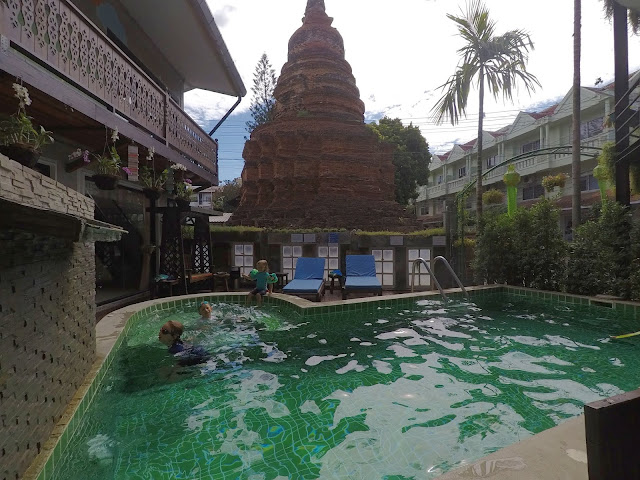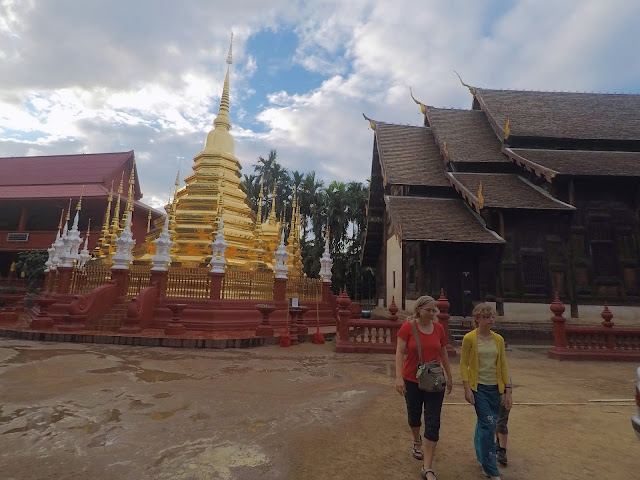Last time we left off as we were whisked away from our guest house to start our 3-day trek to visit the hill tribe villages in northern Thailand!
We got a quick introductory video on the Mirror Foundation, the NGO that ran the trek and homestay program and met our guides.
 |
| Is it still a tree fort if it's just on stilts? Stilt fort? |
Pe’ was our official guide, spoke some English, and ended up being our cultural ambassador. Belu was her cousin and our actual guide, spoke no English but seemed to be the expert on the routes, medicinal and edible herbs, and the one carrying the machete. Dum was the dog that followed Pe’ for security.
 |
| Left to right, top to bottom: Pe', Belu, Middle Child, Dum |
 |
| Forest herbs being applied to Eldest's scraped knee. Worth noting: when Dum got bit by another dog she used off-the-shelf disinfectant |
 |
| This is totally a trail. Totally. |
We discovered that the boundary between hot season and wet season is not “mild” season – rather it means each day is either 100F or pouring rain. The first day was former, and we suffered mightily (especially whichever adult was carrying Danger Monkey). We had Lunch and rest stops in field houses, built near the farms so that farmers can get started early. We had to do a fair amount of bushwhacking with the machete to get through some overgrown trails (this is not a busy season, even for the locals), and once had to partially disassemble a bamboo animal fence to get through. Pe’ was unconcerned, and didn’t think the cows would escape.
 |
| Yup. Definitely a trail. |
 |
| It turns out bamboo and banana leaves can be used to build basically anything. |
 |
| There were butterflies *everywhere*. How novel to experience a fully functioning ecosystem! |
 |
| We were told the rains were late this year. Bad for farmers, but good for hiking. |
 |
| Mist on the mountains. |
Agriculture in the region we were trekking through was primarily subsistence, although some villages had started to farm cash crops and sell one of their two annual rice harvests. Later, when we asked about the traditional houses and buildings made of teak, bamboo, and grass we were told that the people preferred “strong houses” because they didn’t need to get rebuilt every year or two, but building strong houses takes money, which takes cash crops, which takes space, which means clearing jungle, which means losing the nearby resources needed to build traditional houses. So it was sort of a one-way transition.
 |
| Fish ponds. Rice paddies were between harvests, and not yet flooded. |
 |
| Even though it looks like wild jungle, this is basically all managed agriculture. |
The distinction between traditional villages and “economic” ones (we think she meant “commercial”) was pretty stark. The first village we stayed in, with the Lahu tribespeople, had no electricity and the only running water was from rain cisterns a little ways up the hill. The Akha village was a little more integrated with the local economy, and actually had electricity after about 8 PM and the chief wore a gold wristwatch. We stayed with the village chief in both places, and were put up in the nicest buildings available. Though honestly the field houses seemed just fine, and actually let the breeze in much better.
 |
| Our Lahu homestay. Kitchen on the left, bedrooms up above, dogs and laundry underneath. The big open windows let the swallows that nested underneath the house fly through and eat mosquitoes. |
 |
| Dum is a very good boy |
 |
| Keeping a healthy distance away from mama duck |
In each village we were treated to some traditional dancing, with everyone bringing out their fancy traditional outfits and doing a few dances and songs. It wasn’t exactly the right season, and the outfits were awfully hot. This literal song-and-dance routine, in addition to the whole home-stay program, has become a common way for hill tribes to make a little extra money without having to sacrifice traditional ways of life.
 |
| Eldest trying on the traditional Lahu ceremonial costume. The joke will be on us when we find out later that she accidentally got married that morning. |
 |
| Late-night dance in the Akha village. |
 |
| Photo op! The small boy insisted on being front and center. |
Village life itself was pretty laid back. There were chores of course, and during the day the village emptied as the villagers all went out to the fields to tend rice seedlings or collect bamboo shoots in the forest, but there was still plenty of relaxing and talking into the evening after the sun went down. About 50% of village concerns appeared to be dog management, trying to keep various packs of dogs where they were supposed to be and/or not fighting with the other packs of dogs. The dogs were security, mostly from animals. The first night one of the village dogs found a poisonous snake in the gutter, which a village woman unceremoniously clubbed to death and threw down the slope for the chickens to eat.
 |
| Must try all the rolling toys |
The mountain tribe food was more or less unlike anything we had ever had, and was universally amazing. Some notable examples were “Galangal”, whose boiled stalks tasted like pumpkin pie spices and whose flower buds are spicy like chilli peppers, “barrab”, a salad made from chopped pig wrapped in wild mint leaves (normally served raw, but also amazingly delicious cooked to a safe temperature), banana flower fritters, pumpkin curry, whole-chicken soup full of organs and feet, sugar-sweet pineapple straight from the field, infinite bananas, and every village has their own spicy paste made from chilis, small river fish, and whatever other aromatics were within 100 meters of the kitchen.
 |
| Breakfast was about a dozen different sticky rice, coconut, and bean concoctions. |
 |
| Lunch stop on the first day, in the middle of a banana plantation |
 |
| Pe' sets the table |
 |
| Making desert. Roasted coconut, wrapped in sweetened rice-flour dough, steamed in banana leaf envelopes. |
 |
| Utensil use varied by tribe. Akha use sticks, Lahu (pictured above) eat mostly by hand. Also: a kitten under the table. |
 |
| Best meal of the trip. Barrab, pumpkin curry, galagal stalks and flowers, forest garlic, wild mint, and other aromatic leafy things that we never found out the names of |
 |
| More of the same for breakfast, but also with steamed baby pumpkin vines! |
After lunch (and after waiting out the hottest part of the day in the hammocks pictured above) we hiked up the mountain to a waterfall. We were told later by one of the villagers (Atto, who had lived in Bangkok from age 5 until 25 and spoke pretty good English) that we saw "the best one".
 |
| As bridges go in rural northern Thailand, this one was pretty good. |
 |
| Cool and refreshing |
The next day we headed back to the hustle and bustle of the slightly-less-primitive villages and cosmopolitan Chiang Rai. The car and driver that were supposed to bring us the last leg of the trek back to the Karen village for a weaving demonstration wasn't answering his phone, so Pe' called up her niece to come bring us some more water and drive Eldest back on her motorbike.
 |
| "Look Ma, No Helmet!" |
The rest of us eventually made it back as well, and found Eldest had already been taught the basics and had generated about an inch of serviceable cloth. Everyone got in on the project and we hung out through a rainstorm. The littles played make believe games in motorcycle helmets and Danger Monkey got her hair done by Pe’s niece.
 |
| Danger Monkey's job is to eat ALL THE FRUIT |
On our way back to our guest house we took a detour to visit the White Temple, and all three kids got their first ride in the back of a pickup truck.
 |
| In the distance: GIANT WHITE BUDDHA STATUE. It is unrelated to the White Temple. |
 |
| On second thought, let us not go to the White Temple. 'Tis a silly place. |
 |
| Abandon all hope ye who enter here |
 |
| When life gives you temples, paint that shit gold |
The trek and homestays were a pretty amazing experience, and we talked about how it's good to re-calibrate your assumptions about the range of human experience from time to time. A lot of the things we think we need seem more frivolous than they did before, and Michael deeply appreciates his cushy desk job after imagining life working a pineapple plantation planted on a 60-degree slope. But the time spent in the villages also reinforces our belief that people are basically people the world over. The Akha chief's daughter was heading into Chiang Rai to have a baby the day that we left, and we waved goodbye as she was packed into the family truck along with a week's worth of food and clothes. We had danced and eaten with her sisters and mother, our kids played with her older children. Even though we had basically zero common language, it highlighted the foundational humanity that connects us all.





















































